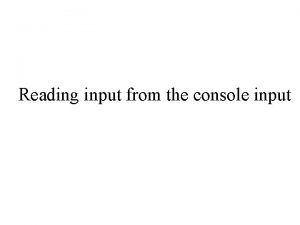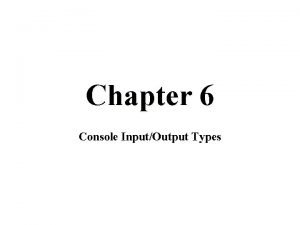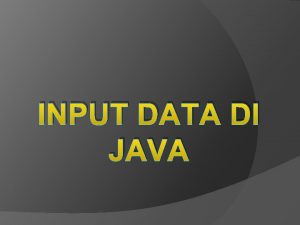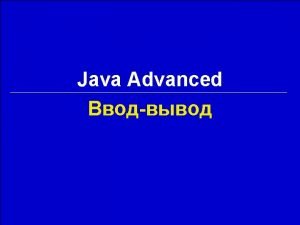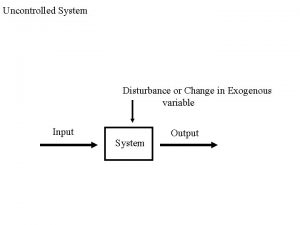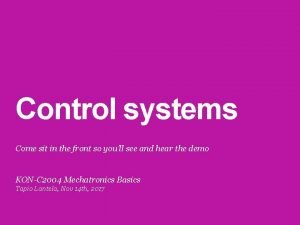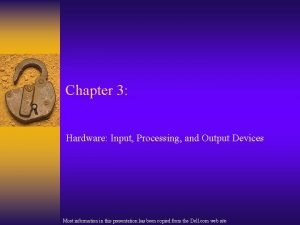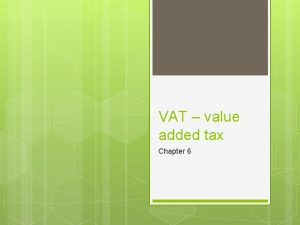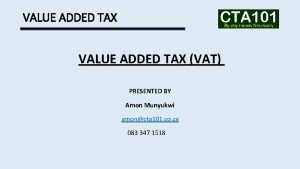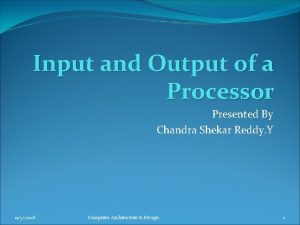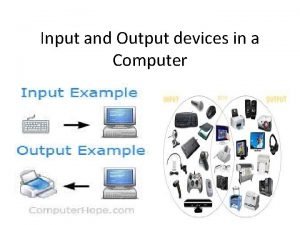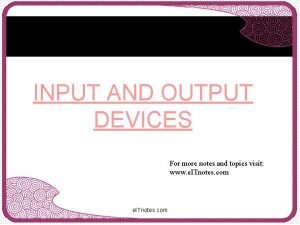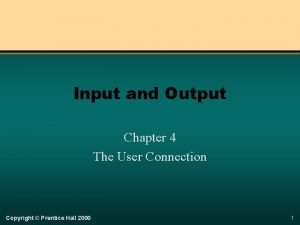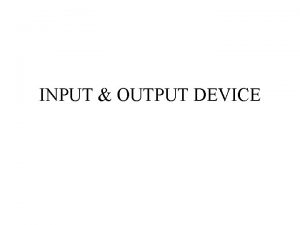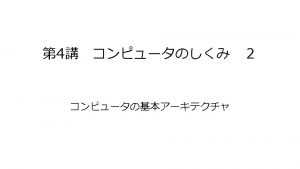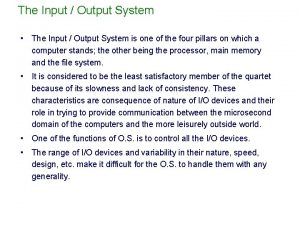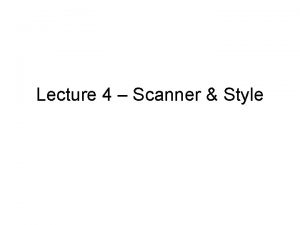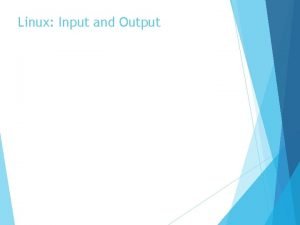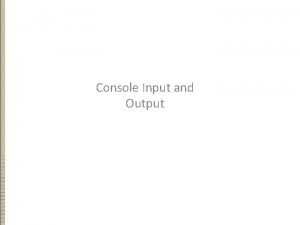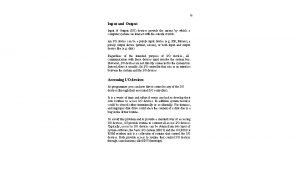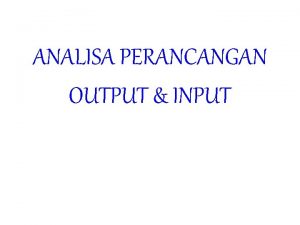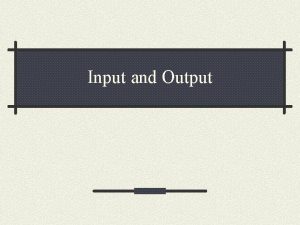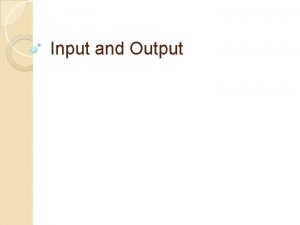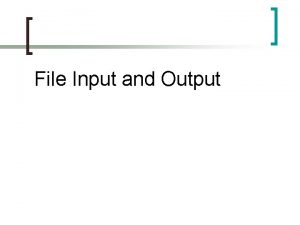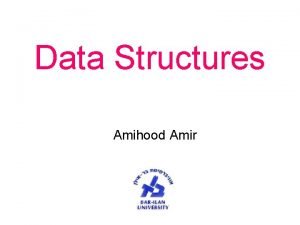Input and Output The system console In the




















- Slides: 20

Input and Output The system console

In the beginning … • When computers were relatively expensive and rare, most users interacted with a terminal – CRT screen with keyboard – Remotely attached to a central, shared computer • Although PCs have by and large put an end to this model, and windowing systems have largely put an end to the notion of a single screen, the model lives on in the form of the system console

Console I/O in Java • Although Java is better-known for its deep support of GUI interfaces, a simple console interface is available as well • We will use this model for most of the semester, as it is the most like the model used by the majority of programming languages, and will make the file I/O model easier to follow

Output methods: println • We have already used the println method in several program examples • The syntax is: System. out. println(arg); – Where “arg” is a String expression or an expression of one of the primitive types (int, double, char, etc. ) – To output more than one value, include at least one String and use the + operator to concatenate additional values with the String

Output methods: print • The print method is identical to the println method, except for the absence of “ln” and one aspect of its action: – When the println method is called, it automatically places the cursor on the next output line when it has finished outputting its argument – The print method, on the other hand, leaves the cursor at the end of the current line when it has completed its output

Example System. out. println (“Here is a brand new line: ”); System. out. print (“But despite the capital letter”); System. out. print(“This is not a new line at all”); Output: Here is a brand new line But despite the capital letter. This is not a new line at all

Formatting Output • We call the space occupied by an output value the field. The number of characters allocated to a field is the field width. The diagram shows output right-justified in a field width of 6 (spaces are represented by dashes)

The printf method • The printf method uses the concept of field width to format console output • printf takes a minimum of one argument, and may take several – The first argument is the control string, which specifies the format for the remaining arguments, if any – If the control string is the only argument, its contents are an ordinary string literal, and printf works exactly like print – If there additional arguments, they follow the control string

Control Strings • Integers %<field width>d • Example: System. out. printf(“The result is: %5 dn”, 100); Output: The result is: 100 • In the example above, the number is printed right -justified in a field of 5 spaces

Control strings • Real Numbers %<field width>. <decimal places>f • Example: System. out. printf(“You owe: $%7. 2 fn”, 3. 15679 e 2); Output: You owe: $ 315. 68 • In the example, the specified field width was one space wider than required to print the number with 2 decimal places • If you specify a field width that is too narrow for the output, the field width value is simply ignored

Control strings • Strings %s • Example: System. out. printf("%10 s%10 sn", "Yours", "Mine", "Ours"); • Output: Yours Mine Ours

Format Specifiers for System. out. printf

Right and Left Justification in printf • The code double value = 12. 123; System. out. printf("Start%8. 2 f. End", value); System. out. println(); System. out. printf("Start%-8. 2 f. End", value); System. out. println(); will output the following Start 12. 12 End Start 12. 12 End • The format string "Start%8. 2 f. End" produces output that is right justified with three blank spaces before the 12. 12 • The format string "Start%-8. 2 f. End" produces output that is left justified with three blank spaces after the 12. 12

Standard input • The System class has a member object named in which is analogous to member object out: we can use this object to read input from the keyboard • The read method of System. in reads data in the form of bytes (ASCII character data); in order to read even simple type data, we need to associate System. in with an object of a class defined in the java. util. * package, Scanner • We can read values of the simple numeric types from the keyboard by using the next method of a Scanner object

Example import java. util. *; … Scanner kb; double d; int i; kb = new Scanner(System. in); System. out. print(“Enter a real number: ”); d = kb. next. Double(); System. out. print(“Enter a whole number: ”); i = kb. next. Int(); System. out. println(“You entered: ” + d + “ and ” + i);

Output from example Enter a real number: 4. 35 Enter a whole number: -9 You entered 4. 35 and -9

The prompt/read/echo pattern • The previous example illustrates a pattern of program behavior that should be used when your program reads keyboard input: – Prompt: a message to the user requesting input; for example: System. out. print(“Enter a real number: ”); – Read: a line of code that reads the requested data; example: d = kb. next. Double(); – Echo: Write out the data read in so user can see what is actually stored in memory; example: System. out. println(“You entered: ” + d + “ and ” + i);

Dealing with users • When reading keyboard input, it is best to prompt for and read one data item at a time; while this can be tedious to program, it provides an unambiguous interface to the user – s/he knows exactly what the program expects and can proceed accordingly

Reading String data from the console • To read String data, we can apply the next() method of the Scanner class; next() will read all of the text the user types until s/he hits the enter key or types another white space character, as in the example below: Scanner kb = new Scanner(System. in); String my. Input; System. out. print(“Enter your name: ”); my. Input = kb. next();

Reading String data from the system console • The code on the previous slide will only read the first word the user types; for instance, if I typed Cathleen M. Sheller, then only the word “Cathleen” would be stored as my. Input • The next. Line() method can be used to read an entire line of text, as in the example below: Scanner kb = new Scanner(System. in); System. out. print (“Enter your full name: ”); String full. Name = kb. next. Line()
 Console input and output in java
Console input and output in java Character oriented console i o function
Character oriented console i o function Format output design
Format output design Input console java
Input console java Java console input
Java console input Input system output
Input system output Input system output
Input system output Information system input processing output
Information system input processing output Automated input device
Automated input device Output devices in vr
Output devices in vr Input vat and output vat
Input vat and output vat Input vat and output vat
Input vat and output vat Vat input
Vat input Conclusion for input and output devices of computer
Conclusion for input and output devices of computer Output devices examples
Output devices examples Conclusion for input and output devices of computer
Conclusion for input and output devices of computer Objectives of input and output devices
Objectives of input and output devices Input and output devices of computer
Input and output devices of computer Optical mark reader is input or output
Optical mark reader is input or output Input and output devices conclusion
Input and output devices conclusion Input output channels in hci
Input output channels in hci
